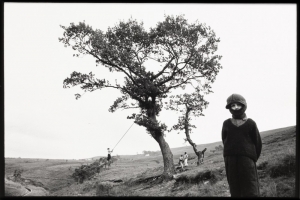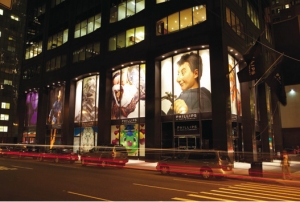|
Displaying items by tag: henri cartierbresson
Selections from the George Stephanopoulos Collection presents the works of artists who happen to be important photographers. The photographic prints in the exhibition are a sampling of over 120 works recently donated to The Hyde Collection by television journalist George Stephanopoulos and his family.
Photographs by Henri Cartier-Bresson, French (1908-2004); Williams E. Dassonville, American (1879-157); Mike Disfarmer, American (1884-1959); Larry Fink, American (b. 1941); Mario Finocchiaro, Italian (1920-1999); Leonard Freed, American (1929-2006); Yousuf Karsh, Canadian, (1908-2002); Jeannette Klute, American (1929-2009); Leon Levinstein, American (1920-1988); Joel Meyerowitz, American (b. 1938); Michael A. Smith, American (b.1942), and Karl Struss, American (1886-1981) are in the exhibition.
Henri Cartier-Bresson’s iconic photography book, “The Decisive Moment,” has been republished, 62 years after the highly influential collection of his early work was first released.
The new publication by the German publisher Steidl is a facsimile of the original book, with 126 photographs taken by Cartier-Bresson between 1932 and 1952 and an elegant collage cover by Matisse.
“It is a book that has already gone down in photography history, and that will continue to do so,” said Irène Attinger, head of the library and bookstore at the Maison Européenne de la Photographie, a contemporary photographic art center in Paris, which now has both original and republished copies of the book.

“Bruce Davidson/Paul Caponigro: Two American Photographers in Britain and Ireland,” at the Yale Center for British Art, is a strange but memorable pairing. It joins the Magnum photojournalist Bruce Davidson, best known for his aggressive New York street and subway photography, to a spiritually minded landscape photographer in the mold of Ansel Adams and Minor White. And although its title suggests some shared expatriate experience, a split quickly develops.
The curators, perhaps acknowledging as much, divide the third-floor galleries neatly down the middle. At times, it seems as if Mr. Davidson and Mr. Caponigro are re-enacting a classic contest in 20th-century photography, a competition between the meticulously technical, landscape-driven Bay Area School of Adams and Edward Weston, and the spontaneous street photography of Mr. Davidson’s mentors, Cornell Capa and Henri Cartier-Bresson (who is said to have remarked, “The world is falling to pieces, and all Adams and Weston photograph is rocks and trees.”)

On 11 and 12 December 2014 Sotheby’s New York will present 175 Masterworks To Celebrate 175 Years Of Photography: Property from Joy of Giving Something Foundation, a single owner sale of the most significant collection of photographs in private hands today. The works to be offered date from photography’s earliest years in the 1840s to contemporary 21st Century color images and include major photographs from all of the medium’s most important practitioners including: Julia Margaret Cameron, Henri Cartier-Bresson, Walker Evans, William Eggleston, Robert Frank, Gustave Le Gray, Irving Penn, August Sander, Alfred Stieglitz, and Edward Weston, among others. The collection was meticulously put together over decades by Howard Stein (1926-2011), one of photography’s greatest collectors, whose vision and keen understanding of the medium informed his purchases. Mr. Stein donated the collection to the Joy of Giving Something Foundation, a not-for-profit organization dedicated to the photographic arts, which is the sole beneficiary of the sale. Highlights will be shown in San Francisco, Los Angeles, and Paris prior to the full exhibition in New York. The pre-sale estimate of $13/20 million is the highest ever for a Photographs auction.
“I didn’t read a lot,” Dennis Hopper (1936-2010) once confessed, “but the idea of the decisive moment, catching something at a given moment, was very interesting to me.” Consequently, an unexpected presence presides over “The Lost Album,” an exhibition of Hopper photographs at the Royal Academy, London (through October 19). As you walk around, you keep being reminded of Henri Cartier-Bresson. The great Frenchman was obviously Hopper’s principle influence when he picked up a camera.
Hopper’s best images are at once formally perfect and utterly fleeting. Take his picture of Ed Ruscha — his friend and fellow artist — in 1964, for example. Ruscha, looking almost ridiculously handsome in the James Dean manner, is standing on the street in Los Angeles. Behind him is a window through which a neon sign reads “TV Radio Services.” Mirrored in the glass of the window are the road and the buildings on the other side of the street.

This fall, Phillips will sell photographs from the Art Institute of Chicago’s illustrious collection. Works by Robert Frank, Henri Cartier-Bresson, Edward Weston and Irving Penn will be offered during sales in October in New York and in November in London.
The Art Institute of Chicago began organizing photography exhibitions in 1900 and has been building its own collection for nearly 65 years. Ellen Sandor, Chair and Curator of the Art Institute of Chicago’s photography department, said, “In 2014 we celebrate our fortieth anniversary as a separate curatorial department and the fifth anniversary of our dedicated galleries in the Art Institute’s Modern Wing. Those two anniversaries represent continuity and change—both essential to our progress. We have spent three and a half years to assess our holdings, with a view to refining and diversifying the collection as well as better understanding the treasures that we possess. Proceeds from the sale will support future acquisitions, and we are grateful to Phillips for working with such care and consideration on this sale.”
The two sales will be complemented by an online selling exhibition in December. Highlights from the collection will go on view in New York, Chicago and London prior to the sales.

An exhibition titled At War with the Obvious: Photographs by William Eggleston is now on view at the Metropolitan Museum of Art in New York. William Eggleston (b. 1939) became pioneering force in modern photography during the 1960s and helped legitimize color photography as a respected art form. He also popularized the dye-transfer color process, a practice that until then was primarily used by commercial photographers. Eggleston, who remains a prominent figure in the modern art world, draws inspiration from a number of sources including the photography of Robert Frank (b. 1924) and Henri Cartier-Bresson (1908-2004) as well as the musical compositions of Johann Bach.
A native of the Mississippi delta region, Eggleston’s photographs often depict the inhabitants as well as the physical landscape of the area. Drawn to seemingly ordinary subject matters, Eggleston is able to evoke a sense of complexity and raw beauty from the mundane. Often featuring roadside snapshots, backyard barbeques, parking lots, and diners, Eggleston’s photographs act as a lush interpretation of the American vernacular.
At War with the Obvious commemorates the Met’s acquisition of 36 dye-transfer prints by Eggleston, which took place in the fall of 2012. The addition fleshed out the museum’s Eggleston collection and included his first portfolio of color photographs from 1974, 15 prints from his seminal book, William Eggleston’s Guide (1976), and seven other important works from a career that has spanned over 50 years.
At War with the Obvious features a number of Eggleston’s most recognizable images including Untitled (Peaches!) (1970), Untitled (Greenwood, Mississippi) (1980), and Untitled (Memphis) (1970). The exhibition will be on view through July 28, 2013.
|
|
|
|
|